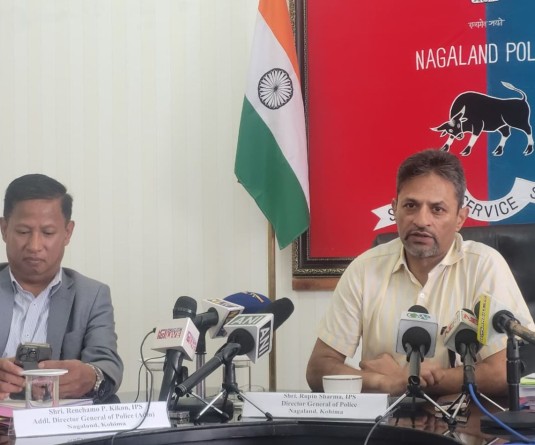Mithun at ICAR- National Research Centre on Mithun, Medziphema in Nagaland. (Morung Photo)
Our Correspondent
Kohima | October 20
Indian Council of Agricultural Research (ICAR)-National Research Centre on Mithun, Medziphema has developed an alternative package of practices of Mithun rearing under a Semi-Intensive Rearing system under Tribal Sub Plan (2016-2021). So far, the institute has established 26 semi-intensive Mithun rearing models in Arunachal Pradesh, Nagaland, Manipur and Mizoram.
Yangkhullen is a small town in the Senapati district of Manipur. The farmers are entirely dependent on agriculture and Mithun farming as a source of income and have been rearing Mithun since time immemorial.
The village due to its strong inter-cultural linkages with Mithun has even formed the Zangna Society for Cultural and Rural Development that will be responsible for its conservation and propagation.
The society had about 150 members with around 220 mithuns in the year 2016. Like all other Mithun rearing villages, they have been adopting the age-old method of letting loose their mithuns in the community forest without any provision of shelter and supplementary feeding except the occasional provision of salt.
“This method, however, has resulted in the death of 20 mithuns every year due to the falling of the Mithun from the steep terrain and mountains,” a booklet on the success stories stated.
The Mithun farmers approached ICAR-NRC on Mithun seeking a solution to their problem in 2016.
ICAR-NRC on Mithun conducted a Mithun mela cum Technology Injection Programme in 2017 and introduced the semi-intensive Mithun rearing model in the village by extending 30 rolls barbed wires, 70 CGI sheets, 3 raincoats of gumboots and raincoats. One and a half kilometres of forest area was fenced.
Impact of technology
As the farmers are solely dependent on Mithun they would sell around 5 mithuns every year.
Since the intervention, they have been able to sell about 10 mithuns per year and even observed an increase in the Mithun population from 220 (2016) to 300 (2020).
An increase in the number of Mithun farmers was also recorded in the society from 150 to 160 members. A total of Rs 2,900,000 was earned as profit during the period.
The intervention resulted in no mortality record again from Mithun falling of steep mountains, better monitoring and supervision of the Mithun and decrease in the death of calves from predator attacks.
Mithun is akin to gold for Haipi
For Haipi in Kangpokpi district of Manipur, Mithun is akin to gold and is one of their most important assets.
The village has been rearing Mithun since 1986 and has established a society "The Haipi Mithun Rearing Co-operative Society Limited" for the welfare of the mithuns in the village.
Apart from rearing Mithun, piglets and poultry, the majority of the farmers practice subsistence agriculture under jhum fields to support their livelihood. Mithuns in the village are generally reared without much supervision and are let loose in the community jungles.
A Mithun herdsman is employed to monitor the mithuns and occasionally feed them salt. But due to the vast jungle area of the village, in most cases, the herdsmen are not able to monitor all the mithuns as they tend to stray deep into the jungles.
As a result, mithuns would trespass into the agricultural fields of the neighbouring villages and often get shot dead in such instances. However, in some cases, Mithun owners are required to pay a hefty fine (Rs 500 per Mithun footprint noticed in damaged fields) as compensation for the crop damage. The society on their part has been trying to erect bamboo fencing and digging trenches to prevent the trespassing of animals but have failed at most times. To add further, the village has been witnessing a disease outbreak almost every three to four years gap as a result they have suffered huge economic losses.
Due to these constant problems, the Mithun farmers under the Haipi Mithun Rearing Co-operative Society Limited approached ICAR-NRC on Mithun and requested some assistance to tackle their problems in 2016.
ICAR-NRC on Mithun introduced the semi-intensive Mithun rearing model in the village by providing the 40 rolls barbed wires, 70 CGI sheets, 5 pairs of gumboots and raincoats.
Impact of the technology
Since the intervention, there has been a significant increase in the Mithun population from 40 to 60 in number. Around 5kms of the forest area has been fenced preventing the mithuns from trespassing into the nearby agricultural fields.
Four Mithun sheds have been constructed for providing shelter to the mithuns. There has also been an increase of four number of mithun farmers in the society.
More mithuns are now available for sale and to date. They have sold 16 male mithuns and 10 female mithuns at an average price of Rs 80,000 and Rs 70,000, respectively.
A total of Rs 1,980,000 was earned as profit since the intervention, the booklet stated.
This is the last of a two part series.




